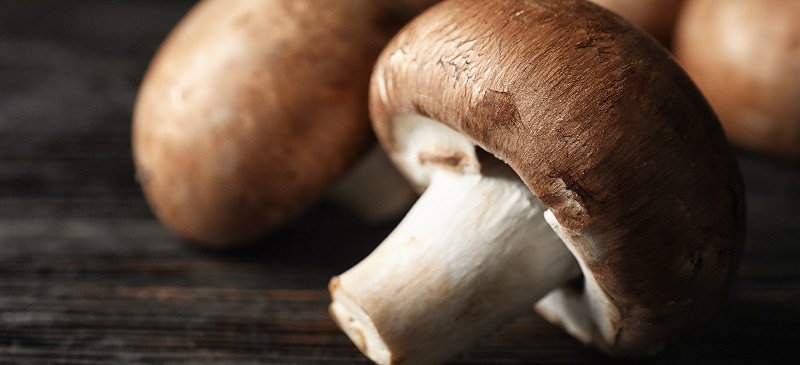When it comes to sticking to a healthy diet, disease-fighting mushrooms check off all the boxes. Mushroom nutrition is low in carbohydrates and calories but a great source of B vitamins, trace minerals, fiber and even protein.
Mushrooms are also anti-inflammatory foods, and mushroom nutrition contains high levels of beta-glucan compounds that keep immune cells alert, plus a powerful antioxidant called ergothioneine that helps lower bodywide inflammation.
The medicinal use of mushrooms has a very long tradition in Asian countries that dates back thousands of years. In China, for example, certain types have historically represented “a combination of spiritual potency and essence of immortality.”
Although their use in the Western Hemisphere only started increasing in the past several decades, numerous recent studies show that they provide an array of vital, biologically active compounds.
You may wonder a few things about mushrooms and mushroom nutrition, such as:
- What are the health benefits of mushroom?
- Can I eat mushrooms every day?
- Which mushrooms are safe to eat? Are some mushrooms bad for you?
- Is a mushroom a protein or a carb?
- Are mushrooms vegetarian?
Let’s take a look below at what you need to know.
Health Benefits
1. Fights Cancer Cell Growth
Known to be a natural cancer treatment and one of the best foods for increasing “natural killer cells” — the type of immune cells that seek out and destroy dangerous cancerous cells — mushrooms are praised as powerful cancer-fighting foods.
Thanks for their antitumor, antimicrobial and antioxidant effects, according to recent studies, the anti-cancer compounds found in mushrooms play a crucial role in protecting against oxidative damage and killing off cancer cells to prevent tumor formation. Protective compounds found within these special fungi include:
- triterpenes
- phenolic compounds
- polysaccharides
- sterols
- eritadenine
- chitosan
This means that mushroom nutrition can help block DNA damage and stop cells from mutating, all while protecting healthy cells and increasing the body’s ability to detoxify itself of dangerous substances.
In addition, a systematic review and meta-analysis of observational studies published in Advances in Nutrition in March 2021 found that revealed that consuming at least two mushrooms per day could potentially lower cancer risk by as much as 45 percent. The researchers concluded: “The association between higher mushroom consumption and lower risk of cancer, particularly breast cancer, may indicate a potential protective role for mushrooms in the diet.”
2. Boosts Immune Function
According to a 2020 report published in the journal Molecules, mushrooms contain compounds and complex substances with “anti-diabetic, anti-hyperlipidemia, anti-fungal, anti-inflammatory, immunomodulatory, antioxidant, anti-aging, anticancer, antiviral, and hepato-protective” effects.
That may sound like a mouthful, but it means that they can enhance almost every system in the body and protect you from numerous diseases since they’re associated with lowered inflammation. Sustaining high levels of inflammation long term has been shown to contribute to chronic conditions, such as diabetes and cancer.
Mushrooms also have the natural ability to fight dangerous bacteria and viruses. In fact, they need to have strong antibacterial and antifungal compounds just to survive in their own natural environment.
This is why it’s not surprising that these beneficial compounds can be isolated from many mushrooms and used to protect human cells. They are even shown to protect against deadly multi-resistant strains of bacteria and other microorganisms responsible for a multitude of health problems.
In fact, some substances present in common antibiotics given to people when they’re sick — including penicillin, streptomycin and tetracycline — are derived from mushroom fungal extracts.
3. Protects Heart Health
Eating more mushroom is one way to lower cholesterol levels naturally. Many types of mushrooms help lower levels of “bad” LDL cholesterol and keep arteries from hardening to reduce the risk of cardiovascular disease.
Mushrooms have sterol compounds that interfere with the production of cholesterol in the liver, yet at the same time they can raise levels of “good” HDL cholesterol. They also contain potent phytonutrients that help keep cells from sticking to blood vessel walls and forming plaque buildup, which can improve circulation and maintain normal blood pressure.
4. Enhances Energy Levels
Mushrooms are a great source of B vitamins, which help support adrenal function and turn nutrients from food into energy that your body can use. B vitamins also support neurotransmitter function to break through brain fog, prevent thyroid disorders and support a healthy metabolism.
5. Supports Weight Management
Studies find that regularly substituting mushrooms for meat might help you lose weight, since they are a low-calorie, nutrient-dense food. In fact, eating mushrooms several times per week has been linked with increased weight loss, reduced waist circumference and less body fat.
6. Provides Vitamin D
Vitamin D deficiency is a serious problem for many people and linked to everything from low immune function to depression. Although vitamin D is best obtained from sun exposure, certain kinds of mushrooms can also provide a hearty dose of this important vitamin as well.
Exposing mushrooms to UV light, whether they’re grown outdoors or indoors under certain light fixtures, increases their concentration of vitamin D. Adding a variety of vitamin D-rich foods to your diet is thought to reduce your risk of cancer, cardiovascular disease, mood disorders and bone loss.
Studies show that certain kinds of mushrooms provide a good amount of vitamin D2 along with vitamin D3 (the kind best utilized by humans) and vitamin D4.
7. Promotes Better Brain Function
Is chronic stress killing your quality of life? Certain types of mushrooms, especially reishi, are also considered adaptogens.
This means they can help your body deal with stress and lower levels of cortisol. Certain mushroom species can also lower inflammation, which is thought to play a central role in cognitive function, mood, energy levels and age-related neurodegenerative diseases.
8. Can Help Strengthen Bones
Because some mushrooms produce vitamin D that you can then consume when you eat them, research suggests that adding them to your diet can help strengthen bone health and protect against serious conditions like osteoporosis.
Vitamin D is necessary for the absorption of calcium, and a deficiency in this key vitamin can increase the risk of fractures, weakened bones and mineralization defects. One animal model in the European Journal of Nutrition demonstrated that feeding mice shiitake mushrooms enriched with vitamin D and calcium helped increase bone mineral density and reduced the risk of osteoporosis.
9. May Support Reproductive Health and Fertility
Thanks to their anti-inflammatory and antioxidant effects, animal studies have found that these fungi can help fight against age-related sexual dysfunctions (desire, arousal, orgasm and pain).
One study found that cordyceps supplementation in rats helped improve sperm motility, survival rates and progressiveness. Other animal studies have found some evidence that these fungi may support healthy levels of reproductive hormones, such as testosterone, and potentially boost libido by increasing energy and stamina.
READ RELATED: Grecia Figueroa Speaks out Against Sexual Harassment After Suing Disgraced San Diego Sup. Nathan Fletcher
Mushroom Nutrition (Plus Types)
Is a mushroom a fungus, a vegetable or a meat?
Although most people think of mushrooms as vegetables, they’re in fact a type of beneficial fungi.
The term “mushroom” refers to any macrofungus with a distinctive fruiting body large enough to be seen with the naked eye and picked by hand. As of now, there are more than 14,000 different mushroom species that grow around the world — and perhaps way more.
There’s still a lot to learn about the many mushroom species on Earth. For example, it’s estimated that there may be more than 140,000 different species in existence, which suggests that scientists only know about 10 percent of the possible species at this time.
Species that grow around the world vary widely, ranging from small to big types and those that come in a variety of colors (brown, tan, red, orange, etc.).
Which mushroom is best for health? Some of the most common types of edible mushrooms include:
Although various types differ in terms of their exact calorie and nutrient count, mushroom nutrition is typically very low in carbohydrates (making them a natural choice for the low-carb or keto diet), calories, fat and sodium. Mushroom nutrition also provides an array of diverse nutrients, including antioxidants, energizing B vitamins, copper and selenium.
A one-cup serving of whole, raw whit mushrooms (about 96 grams) contains approximately:
- Calories: 21.1
- Total Carbohydrates: 3.1 g
- Total Fat: 0.3 g
- Saturated Fat: 0.05 g
- Polyunsaturated Fat: 0.2 g
- Trans Fat: 0 g
- Protein: 3 g
- Sodium: 4.8 mg (0.2% DV*)
- Copper: 0.3 mg (33% DV)
- Riboflavin: 0.4 mg (31% DV)
- Pantothenic Acid: 1.4 mg (28% DV)
- Niacin: 3.5 mg (22% DV)
- Selenium: 8.9 mcg (16% DV)
- Phosphorus: 82.6 mg (7% DV)
- Potassium: 305 mg (6% DV)
*Daily Value: Percentages are based on a diet of 2,000 calories a day.
How to Use (Recipes)
Look for fresh or dried mushrooms in grocery stores, health food stores or at your local farmers market, where you might be able to score some rarer types.
It’s important to buy and eat organic grown mushrooms whenever possible because they’re very porous and have the tendency to easily absorb chemicals from the soil that they’re grown in. Mushrooms can contain high levels of toxins like heavy metals and pesticides when they’re chemically sprayed or exposed to water pollutants, so it’s worth the extra money to buy the best quality you can.
Dried mushrooms might be a bit more expensive than fresh ones, but they’re a good option when mushrooms aren’t in season.
To wash mushrooms, some need just a wipe down with a clean, damp cloth to remove any dirt (like shiitake, portobello, small crimini and button mushrooms). Others, such as the chanterelle mushroom, should be cleaned using a delicate brush.
Since mushrooms absorb water easily, you don’t want to rinse them for too long or keep them submerged in water, as this can make them “water-logged.” A quick rinse to get off any visible dirt is usually enough.
Keep them dry in the refrigerator until the time you’re ready to use them, and remember that they have a short shelf life so the quicker you use them, the better.
Many people like to store them in a paper bag rather than a plastic one. This allows air to move in and out, which can keep them in better condition.
When it come to cooking mushrooms, each type needs to be handled a bit differently. Dried mushrooms, for example, can be rehydrated by combining them with boiling water and letting them sit for about 15 minutes so they plump up to a larger volume.
Large mushrooms like portobellos can be baked and still hold their firm texture, but more delicate mushrooms like shiitakes and cremini are best for sautéing in a pan or wok. Keep in mind mushrooms absorb a lot of liquid at first but later release their water, so don’t feel the need to drown them in sauce or oil.
Mushrooms add an earthy flavor and chewy, hearty texture to all kinds of savory dishes — from omelets and stir-fries to whole grain pilaf or side dishes. They can also be used as a base for mushroom risotto, added to mushroom pasta or cooked into a tasty mushroom sauce.
You can also sauté, roast, grill or stir-fry the fungi for a simple yet delicious side dish.
Here are several mushroom recipe ideas to add more of this flavorful fungi to some easy, healthy meals:
Risks and Side Effects
If you buy mushrooms in supplement form or scavenge for mushrooms that grow in the wild on your own, always look for a reputable brand. If scavenging, consult with a specialist who knows about wild mushrooms and is well-versed in mushroom identification.
Why are some mushrooms bad for you, an is it possible for a mushroom to kill you?
Some mushroom types, such as psilocybin mushrooms and amanita mushroom, also known as psychedelic mushrooms or “magic mushrooms,” contain compounds that can cause symptoms like hallucinations and changes in perception, even when consumed in small amounts. Other mushrooms, like the death cap mushroom, can be toxic or contaminated and are not meant for human consumption, so be careful where you purchase “medicinal mushrooms.”
Also, look for organic mushrooms whenever possible, and if you can’t find these, give dirty mushrooms a good rinse or wipe down to remove residue, bacteria and possibly even insects.
Keep in mind that most mushrooms contain purines that can be naturally found in some plants and are linked to health problems in some cases. Purines break down to form uric acid, which can accumulate and lead to conditions like gout or kidney stones in rare circumstances.
Therefore, if you have an existing problem that’s worsened by purines, you should eat mushrooms in moderation.
Conclusion
- Why are mushrooms good for health? Mushroom nutrition can help reduce cancer cell growth, increase energy levels, enhance heart health, boost brain and immune function, and improve weight control.
- Mushroom nutrition is also very impressive. Although it can vary between different edible mushroom species, there are typically a low amount of calories, fat and carbs in mushrooms in each serving along with a good amount of antioxidants, B vitamins and other micronutrients in mushroom nutrition.
- There are thousands of different species that grow around the world, many of which scientists are still learning about. Common mushroom varieties include shiitake, morel, oyster and portobello mushrooms.
- Keep in mind that not all species are safe for consumption. Certain types can actually be poisonous, and hallucinogenic mushrooms can even cause changes in perception.
- Enjoy mushroom nutrition in a variety of different dishes such as sauces, stews, soups and side dishes to take advantage of the unique benefits that these flavorful fungi have to offer.
!function(f,b,e,v,n,t,s)
{if(f.fbq)return;n=f.fbq=function(){n.callMethod?
n.callMethod.apply(n,arguments):n.queue.push(arguments)};
if(!f._fbq)f._fbq=n;n.push=n;n.loaded=!0;n.version=’2.0′;
n.queue=[];t=b.createElement(e);t.async=!0;
t.src=v;s=b.getElementsByTagName(e)[0];
s.parentNode.insertBefore(t,s)}(window, document,’script’,
‘
fbq(‘init’, ‘3475171552810057’);
fbq(‘track’, ‘PageView’);





